MOHS, Carl Frederich Christian.
(1773 – 1839)
Mohs was educated at the University of Halle, graduating in 1797. Afterwards, he attended the Bergakademie in Freiberg and studied under Werner. On the invitation of his fellow students, George Mitchell and R. Jameson, Mohs traveled to Great Britain in 1802. In 1811, he was appointed curator of the mineral collection at the Johanneum in Graz, Austria. Upon the death of Werner in 1817, Mohs succeeded his former teacher as professor of mineralogy at the Freiberg Bergakademie. Then in 1826, he accepted a position as professor of mineralogy and superintendent of the Royal Imperial mineral collections in Vienna.
Biographical references: ADB: 22, 76. • Barr, Index to Biographical Fragments, 1973: 181. • DBA: I 853, 309-327; II 905, 441-451. • Drugulin, Sechstausend Portraits, 1863: nos. 3717 & 6212. • DSB: 9, 447-9 [by J.G. Burke]. • Fuchs, W., G. Haltmeyer & F. Leydolt, Friedrich Mohs und sein Wirken in wissenschaftlicher Hinsicht: ein biographischer Versuch entworfen und zur Enthüllingsfeirer seines Monumentes im st. Johanneums-Garten zu Grätz. Vienna, 1843. • Hamberger & Meusel, Gelehrte Teutschland, 1796-1834. • Kobell, Geschichte der Mineralogie, 1864: 216-22. • Lambrecht & Quenstedt, Catalogus, 1938: 298-9. • NDB: 17, 715-6 [by W. Kroker]. • Österreich Biographisches Lexikon. • Österreichische Naturforscher, 1951. • Poggendorff: 2, cols. 172-3. • Sarjeant, Geologists, 1980: 3, 1734. • Schaedler, Biographisch Handwörterbuch, 1891: 82. • Schiffner, Alter Freiberger Bergstudenten, 1935-40: 1, 20-3. • Staples, L.W., "Friedrich Mohs and the scale of hardness", Journal of Geological Education, 12, (1964), no. 3, 98-101. • WBI. • World Who's Who in Science: 1195. • Wurzbach, Biographisches Lexikon Österreich, 1856-91.
1. German, 1843.
[Contained within an ornate double rule box:] Friedrich Mohs | und sein Wirken | in wissenschaftlicher Hinsicht. | [ornate rule] | Ein | biographischer Versuch, | entworfen, und zur Enthüllungsfeier seines Monumentes | im st. st. Johanneums-Garten zu Grätz | herausgegeben von | Dr. Wilhelm Fuchs, Dr. Georg Halmeyer, Dr. Franz | Leydolt, Gustav Rösler. | [ornate rule] | Wien, 1843. | In Commission bei Kaulfuss Witwe, Prandel & Comp.
8°: π3 1-48 57; 42l.; [6], [1]-77, [1] p., frontispiece (portrait of Mohs bust with his signiature). Page size: 264 x 170 mm.
Contents: [2 pgs], Title page, verso blank.; [1 pg], Dedication.; [1 pg], Blank.; [2 pgs], "Vorrede."; [1]-77, Text.; [1 pg], 9 lines of text, at bottom, "Gedruckt bei Carl Ueberreuter."
Scarce. The principal biographical source for Mohs, which includes an autobiography to the year 1830.
2. German, 1804 [Periodical].
Sammlung mineralogischer und bergmännischer Abhandlungen ... Erste Band ... Beschreibung des Gruben-Gebäudes Himmelsfürst bey Freyburg im Sachsen. Mit zwei Kupfertafeln. Wein, 1804.
8°: Bd. 1. Beschreibung des Gruben-Gebäudes Himmelsfürst bei Freyberg in Sachsen. No more volumes published.
Very scarce. No more published
Bibliographical references: LKG: VI 116.
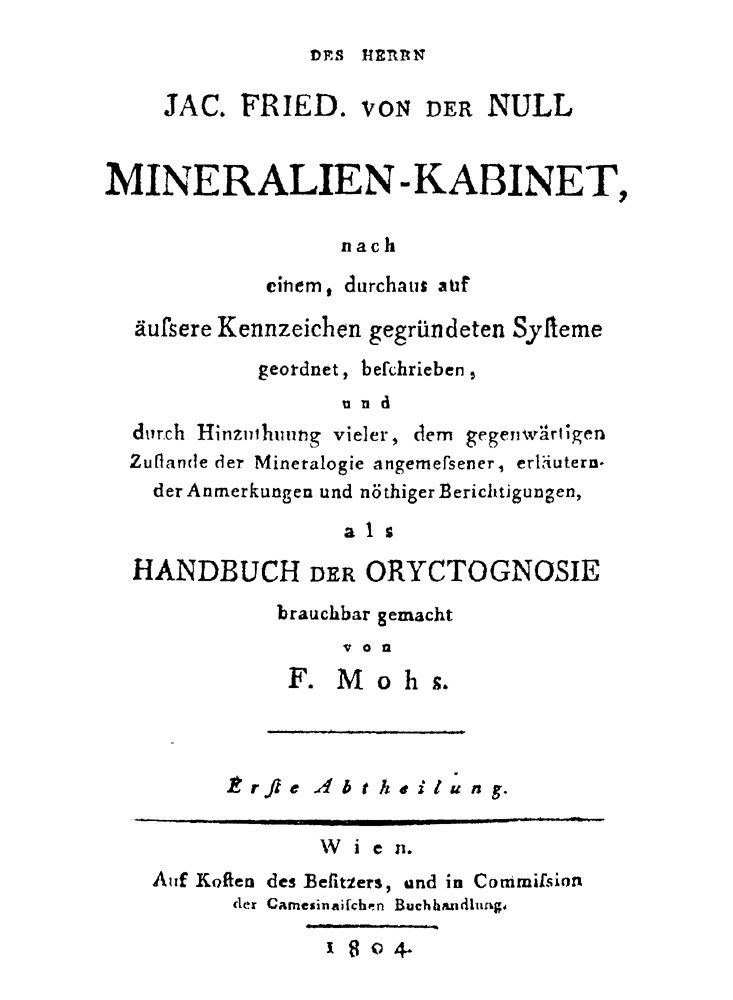
3. German, 1804 [Collection catalog].
Des Herrn | Jac. Fried. von der Null | Mineralien-Kabinet, | nach | einem, durchaus auf | äussere Kennzeichen gegründeten Systeme | geordnet, beschreiben, | und | durch Hinzuthuung vieler, | dem gegenwärgigen | Zustande der Mineralogie angemessener, erläutern- | der Anmerkungen und nöthiger Berichtigungen, | als | Handbuch der Oryctognosie | brauchbar gemacht | von | F. Mohs. | [rule] | Erste [-Dritte] Abtheilung. | [tapered rule] | Wien. | Auf Kosten des Besitzers, und in Commission | der Camesinaischen Buchhandlung. | [rule] | 1804.
3 vols. [Vol 1] 8°: π1 a-d8 e4 A-2O8 2P1; 334l.; [2], [i]-lxxii, [1]-594 p.; [Vol 2] 8°: π1 A-U8 X5; 166l.; [2], [1]-330 p.; [Vol 3] 8°: π1 A-2Y8 2Z7; 368l.; [2], [1]-730, [4] p. Page size: 195 x 115 mm.
Contents: [Vol 1] [2 pgs], Title page, verso blank.; [i]-xlii, "Einleitung."-dated June 1803.; [xliii]-lxxii, "Mineral-System."; [1], "Die Klasse erdiger Fossilien." [2], Blanks.; [3]-594, Text.
[Vol 2] [2 pgs], Title page, verso blank.; [1]-330, Text.
[Vol 3] [2 pgs], Title page, verso blank.; [1]-730, Text.; [4 pgs], "Verbesserungen."
Rare. On the advice of the Irish geologist George Mitchell [ca. 1775-1803], Mohs was commissioned to prepare a systematic catalog of the important mineral collection formed by the wealthy Vienna amateur Jakob Friedrich van der Nüll [see note below]. It is likely that during the examination of the collection and the preparation of this work that Mohs first began to doubt Werner's mineralogical ideas. A chance meeting in 1810 gave Mohs an opportunity to convince Werner of deficiencies in his concepts. Werner remained steadfast, however, causing Mohs to pursue a course of study that would eventually set systematic mineralogy on a new foundation. Van der Nüll's collection was incorporated into the Imperial collections at Vienna in the 1820's.
Second issue: Another, apparently rarer second issue exists which is indentical to the first issue except that the year on the title page reads "1805."
Jakob Friedrich van der Nüll. (Born: ; Died: 1826?) Austrian mineral collector. Austrian mineral collector. Van der Nüll was a banker and businessman in Vienna. Through his resources, he built an exceptionally fine mineral collection. For a curator, he hired Mohs, who arranged the contents according to first Werner's then his own classification scheme. The collection begun in 1797 concentrated on hand-size specimens (2 to 4-inchs), and was considered within a few years to be not only the finest mineral collection in Vienna but all of Germany. This remarkable acheivement was accomplished through the purchasing of no less than eleven important mineral collections before 1807. In 1827, the collection was purchased by the Royal Imperial mineral cabinet in Vienna.
Bibliographical references: Dana's 7th (Bibliography): 77. • Freiesleben, Sächsische Mineralien-Verzeichnisse, 1828: no. 58. • Freilich Sale Catalog: no. 398. • LKG: XV 48. • Partsch, Katalog der Bibliothek, 1851: no. 478. • Sinkankas, Gemology Bibliography, 1993: no. 4522. • Ward & Carozzi, Geology Emerging, 1984: no. 1591. • Wilson, History of Mineral Collecting, 1994: 107-8 & 219. (Nüll) Böckh, F.H., Wiens lebende Schriftsteller, Künstler und Dilettanten in Kunstfache. Wien, B.P. Bauer, 1821: 136. • Burghardt, Von Agricola bis Van der Null, 1950: 149. • Greene & Burke, Minerals in the Age of Jefferson, 1978. • Huber, S. and P. Huber, "Zur Tradition des Mineraliensammelns in Raume Wien," Mitteilungen der Österreichischen Mineralogischen Gesellschaft, no. 128, 77-86: 81-2. • Wilson, History of Mineral Collecting, 1994: 103, 108-8 & 186. • Wurzbach, Biographisches Lexikon Österreich, 1856-91: 20, 426.
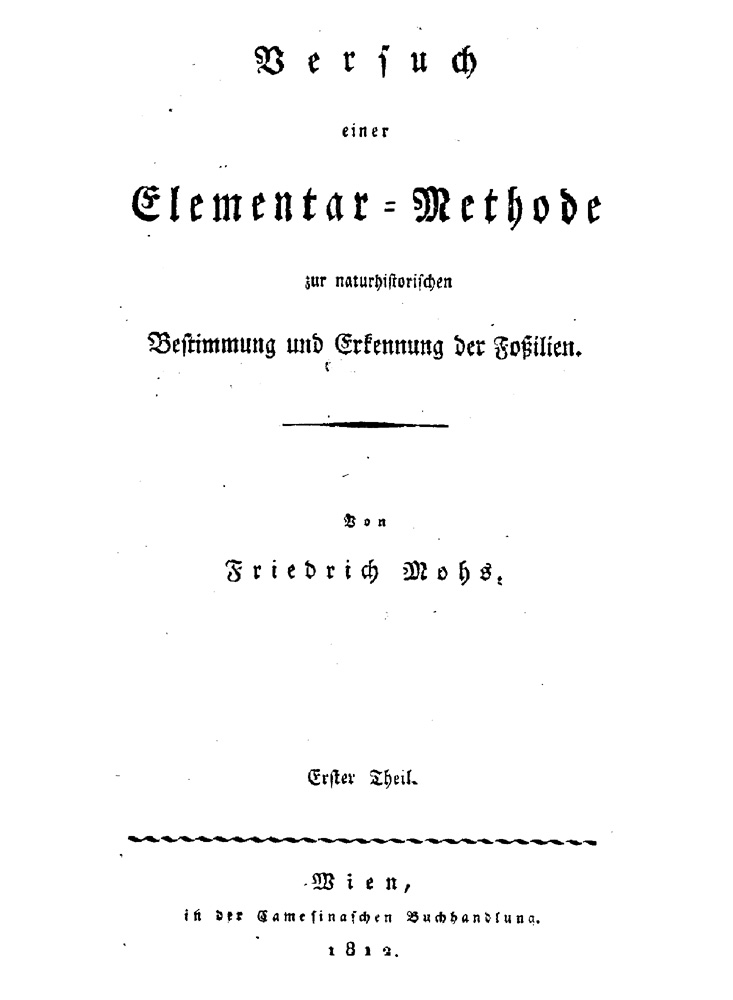
4. German, 1812.
Versuch | einer | Elementar=Methode | zur naturhistorischen | Bestimmung und Erkennung der Foßilien. | [tapered rule] | Von | Friedrich Mohs. | Erster Theil. | [ornate rule] | Wien, | in der Camesinaschen Buchhandlung. | 1812.
8°: a-b8 A-H8; 80l.; [i]-xxix, [3], [1]-128 p. Page size: 225 x 150 mm.
Contents: [i-ii], Title page, verso blank.; [iii]-xxxix, "Vorrede."; [1 pg], Blank.; [1 pg], Sectional title page.; [1 pg], Blank.; [1]-128, Text.
Very scarce. Describes Mohs new approach to a classificatory system in mineralogy. Using the most elementary physical characteristics of a mineral, he developes a natural history method for arranging species. As part of the methodology, Mohs develops for the first time his famous scale of mineral hardness. Miners and mineralogists had long been accustomed to scratch a mineral in determining its species. In an effort to make the procedure more ridgid, Mohs proposed a non-proportional scale of increasing hardness from one to ten as follows: (1) talc, (2) gypsum, (3) calcite, (4) fluorite, (5) apatite, (6) feldspar, (7) quartz, (8) topaz, (9) corundum, and (10) diamond. In later writings, he would add other minerals to obtain intermediate degrees of hardness, but it is his first scale that every geology student still learns today.
Bibliographical references: LKG: IX 33. • Staples, L.W., "Friedrich Mohs and the scale of hardness", Journal of Geological Education, 12, (1964), no. 3, 98-101.
Die Charaktere
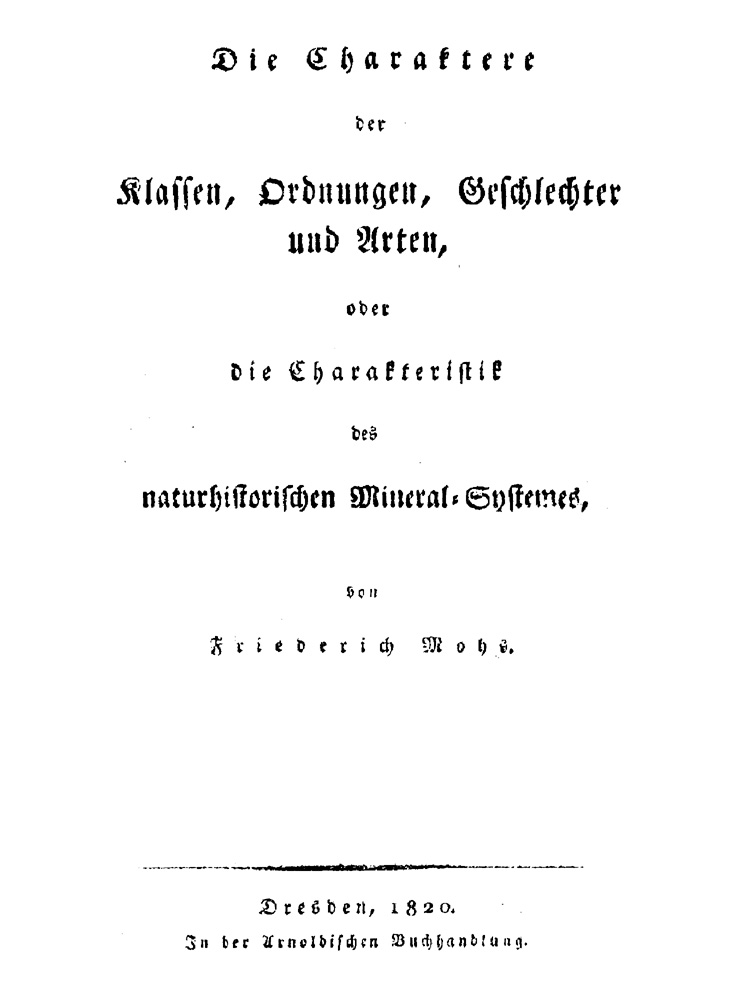
5. German, 1820 [First edition].
Die Charaktere | der | Klassen, Ordnungen, Geschlechter | und Arten, | oder | die Charakteristik | des | naturhistorischen Mineral=Systemes, | von | Friederich Mohs. | [tapered rule] | Dresden, 1820. | In der Arnoldischen Buchhandlung.
8°: 1-78 87; 63l.; [i]-xxvi, 1-100 p. Page size: 190 x 108 mm.
Contents: [i-ii], Title page, verso blank.; [iii]-xxvi, "Vorrede."; 1-100, Text.
Very scarce. Mohs scale of hardness, first outlined in his Versuch einer Elementar-Methode (Wien, 1812), is prominently featured in this work, as is the continuation of his mineralogical system.
6. German, 1821 [2nd edition].
Die Charaktere | der | Klassen, Ordnungen, Geschlechter | und Arten, | oder | die Charakteristik | des | naturhistorischen Mineral=Systemes, | von | Friederich Mohs. | [rule] | Zweite, verbesserte Auflage. | Mit 3 Kupfertafeln. | [tapered rule] | Dresden, 1821. | In der Arnoldischen Buchhandlung.
8°: π7 1-148 151; 120l.; [i]-xii, [2], [1]-226 p., 3 folding plates (showing crystal diagrams). Page size: 196 x 120 mm. Very scarce.
Contents: [i-ii], Title page, verso blank.; [iii]-vi, "Vorrede | zur ersten Auflage."; vii-xii, "Vorrede | zur zweiten Auflage."-dated January 1821.; [1 pg], "Druckfehler."; [1 pg], Blank.; [1]-108, Text.; 109-226, "Characteristik. | Charaktere der Klassen."
Plates: The 3 folding plates are numbered Taf. I-III. Each is signed Haject gest., and all show various crystal diagrams.
Die Charaktere der Klassen, Ordnungen, Geschlechter und Arten des naturhistorischen Mineral-Systemes, von Friederich Mohs. Neu berarbeitet von F.X.M. Zippe. (Wein, 1858).See under: Zippe, FrantiŠek Xaver Maximilian.
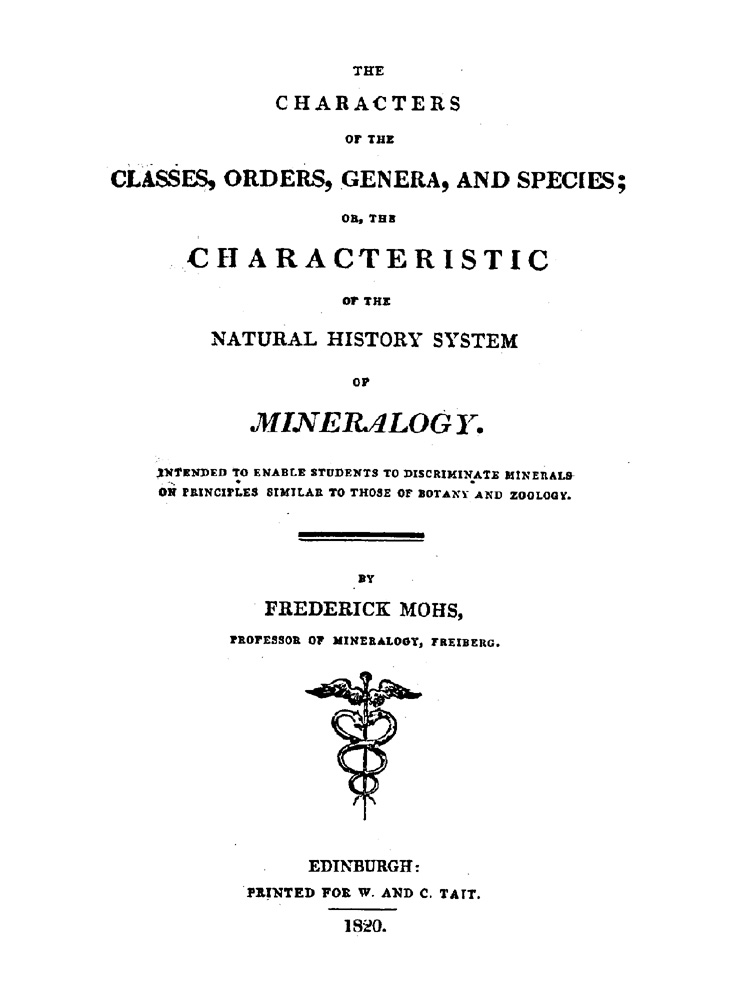
7. English, 1820 [English transl.].
The | Characters | Of The | Classes, Orders, Genera, And Species; | Or, The | Characteristic | Of The | Natural History System | Of | Mineralogy. | Intended To Enable Students To Discriminate Minerals | On Principles Similar To Those Of Botany And Zoology. | [double rule] | By | Frederick Mohs, | Professor Of Mineralogy, Freiberg. | [ornament] | Edinburgh: | Printed For W. And C. Tait. | [rule] | 1820.
8°: xxvii, [1], 109, [3], viii p.
Rare. First separate English edition, translated by Thomas Carlyle from Die Charaktere der Klassen, Ordnungen, Geschlechter und Arten (1820). This work is of importance for bringing Mohs scale of hardness to the English speaking world. Upon its publication, Mohs Die Charaktere der Klassen, Ordnungen Geschlechter und Arten, enjoyed wide popularity among mineralogists of the continent. On this basis, David Brewster editor of The Edinburgh Philosophical Journal, commisioned an impoverished school master to bring out an English translation for his Journal (see: 3, no. 5, pp. 154-76 & no. 6, pp. 317-42 and 4, no. 7, pp. 56-57). These parts were subsequently collected together and republished as a single volume. As it happens, Carlyle, the translator, never again wrote on mineralogy, although he went on become one of the great figures in nineteenth century English literature.
Thomas Carlyle. (Born: 1795; Died: 1881) Scottish essayist, historian & philosopher. Carlyle is best remembered works are: French Revolution, Frederick the Great and Sartor Resartus.
Bibliographical references: Anonymous, "Mohs, Brewster, Carlyle and the table of hardness", Mineral Digest, the Journal of Mineralogy, 8, 82-6. • Dana's 7th (Bibliography): 77. (Carlyle) DNB. • Eminent Scotsmen. • Nouvelle Biographie Générale (Hoefer).
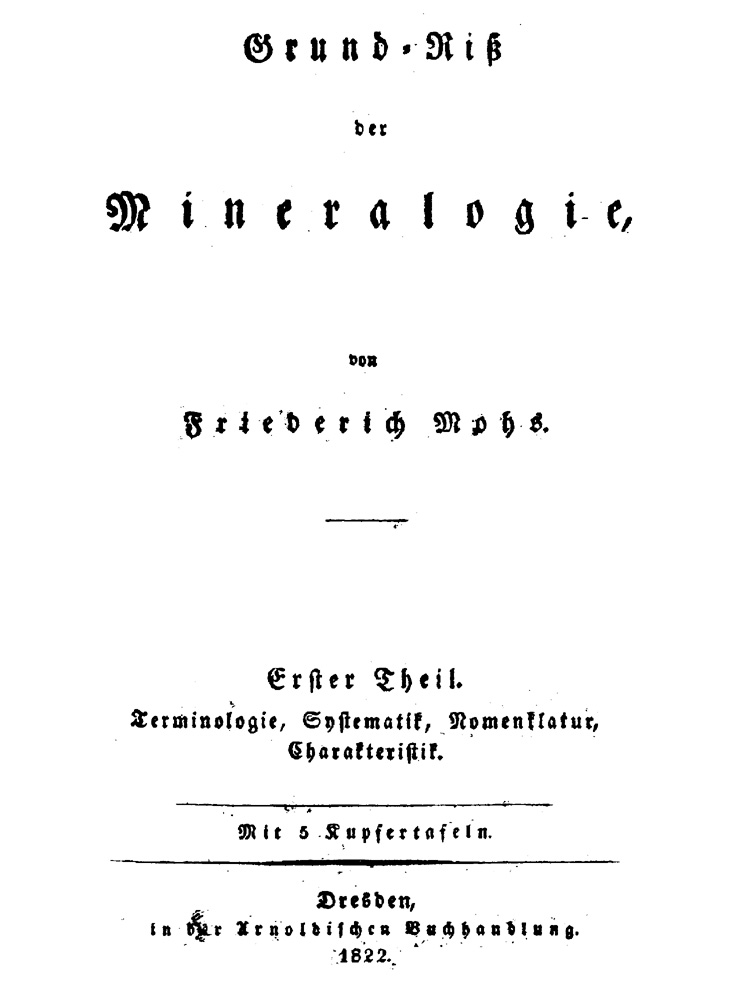
8. German, 1822-4.
Grund=Riß | der | Mineralogie, | von | Friederich Mohs. | [short rule] | Erster Theil. | Terminologie, Systematik, Nomenklatur, | Charakteristik. | [rule] | Mit 5 Kupfertafeln. | [tapered rule] | Dresden, | in der Arnoldischen Buchhandlung. | 1822.
Grund=Riß | ... | Zweite Theil. | Physiographie. | [rule] | Mit 10 Kupfertafeln. | [tapered rule] | Dresden, | in der Arnoldischen Buchhandlung. | 1824.
2 vols. [Vol 1: 1822] 8°: *-***8 ****7 1-378 387; 334l.; [i]-lxii, [1]-604, [2] p., 5 folding plates. [Vol 2: 1824] 8°: *-**8 ***2 1-458 465 [1]-28; 399l.; [i]-xxxvi, [1]-730, [1]-30, [2] errata p., 10 folding plates (164 figs. of crystals). Page size: 192 x 110 mm.
Contents: [Vol 1: 1822] [i-ii], Title page, verso blank.; [iii]-xlviii, "Vorrede."; xlix-lxii, "Inhalt."; [1]-604, Text.; [2], "Druckfehler."; [At end], 5 folding plates.
[Vol 2: 1824] [i-ii], Title page, verso blank.; [iii]-xxii, "Vorerinnerungen."; xxiii-xxxvi, "Inhalt."; [1]-638, Text.; 639-691, "Este Anhang. Mineralien von denen zu erwarten, daß sie Künftig als eigene Species in Systeme werden aufgenommen werden können."; 692-730, "Zweite Anhang. Mineralien, von denen nicht zu erwarten, daß sie Künftig als einige Species im Systeme werden augenommen werden können."; [1], "Register zu dem Grund-Riß der Mineralogie in zwei Bänden, von Friederich Mohs."; [1], Blank.; [3]-20, "Deutsches Register."; 21-25, "Englisches Register."; 26-30, "Französisches Register."; [2 pgs], Errata.; [At end], 10 plates showing 164 figures of crystals.
Very scarce. The first volume of this work, centering on crystallography reached essentially the same conclusions as did Christian Samuel Weiss (although Mohs does not credit Weiss with the discovery, thus spawning a mutual dislike). Mohs extends, however, the four crystal systems proposed by Weiss, namely: rombohedral (hexagonal), pyramidal (tetragonal), prismatic (orthorhombic), and tessular (cubic), with the addition of two new systems whose crystallographic axes were not mutually perpendicular. These new crystal systems were later named the monoclinic and triclinic, and fully described by Karl Friedrich Naumann in 1824. The second volume of the Grundriss contains a systematic description of minerals, founded on a natural history method with classes, orders, genras, and species. The principal addition to the mineral descriptions not seen in previous authors is the explicit mention of the crystal system to which a given mineral belongs.
Bibliographical references: Dana's 7th (Bibliography): 77. • DSB: 9, 447-9 [by J.G. Burke]. • Freilich Sale Catalog: no. 399.
9. English, 1825 [English transl.].
Treatise | on | Mineralogy, | or the | Natural History Of The Mineral Kingdom. | By | Frederick Mohs, | Professor In The Mining Academy Of Freiberg. | Translated from the German, with considerable Additions, | by | William Haidinger, F.R.S.E. | Vol. I. [-III.] | Edinburgh: | Printed For Archibald Constable And Co. Edinburgh; | And Hurst, Robinson, And Co. London. | 1825.
3 vols. [Vol 1] 8°: [a]8 b4 A-2H8 2G1; 243l.; [4], [i]-xxiv, [1]-458 p., 15 plates (80 figures).; [Vol 2] 8°: π3 A-2H8 2G4; 237l.; [6], [1]-472 p., 35 plates (197 figures).; [Vol 3] 8°: π3 A-U8; 163l.; [6], [1]-319, [1] p. Page size: 195 x 120 mm.
Contents: [Vol 1] [2 pgs], Half title page, verso "Edinburg: Printed at the Caledonian Mercury Press."; [2 pgs], Title page, verso blank.; [i]-xiv, "Preface."; [xv]-xxiv, "Contentts of Vol. I."; [1]-18, "Introduction."; [19]-313, Text.; [314]-345, "Part II. Theory of the System."; [346]-367, "Part III. Nomenclature."; [368]-390, "Part IV. Characteristic."; [391]-458, "Characters of the Classes, Orders, Genra and Species."; [At end], 15 plates.
[Vol 2] [2 pages], Half title page, verso "Edinburg: Printed at the Caledonian Mercury Press."; [2 pages], Title page, verso blank.; [1 page], "Contents of Vol. II."; [1 page], Blank.; [1]-16, "Part V. Physiography."; [17]-472, "General Descriptions of the Species."; [At end], 35 plates.
[Vol 3] [2 pages], Half title page, verso "Edinburg: Printed at the Caledonian Mercury Press."; [2 pages], Title page, verso blank.; [1 page], "Contents of Vol. III."; [1 page], Blank.; [1]-66, Continuation of the descriptive mineralogy.; [67]-176, "Appendix I. Minerals, the greater part of which will probably form in the future distinct species in the mineral system."; [177]-188, "Appendix II. Minerals, which will probably never form distinct species in the mineral system."; [189]-288, "Plates and Explanations."-descriptions are printed on recto side of leaves only.; [289]-319, "Index."; [1 page], "Errata."
Very scarce. Translation by William Haidinger from Grundriß der Mineralogie (Dresden, 1822-24). Mohs reached essentially the same conclusions as Christian Samuel Weiss did concerning crystallography. In 1819, Weiss had suggested that four crystal systems existed, namely: rombohedral (hexagonal), pyramidal (tetragonal), prismatic (orthorhombic), and tessular (cubic). In the 1822 volume of his Grundriß, Mohs suggested (ommitting any mention of Weiss' previous work) that six crystal systems existed. The four mentioned already, plus two whose crystal axes were not mutually perpendicular. These were described in full by Karl Friedrich Naumann in 1824, and given the names monoclinic and triclinic.
Until this very fine translation of the Grundriß appeared, Mohs mineralogical ideas were largely confined to Germany. However, the translator, Haidinger, was also a very competent mineralogist in his own right, and the augmentation he brought to his translation transformed the work into the standard mineralogical reference of the natural history method for the period 1825 to 1850. So successful was this work that James Dwight Dana used it as a model for the first edition of his own System of Mineralogy (1st ed., New Haven, 1837).
Volume one consists of a general description of mineralogy, terminology, crystallography, properties, theory of the system, and nomenclature. Volume two contains general descriptions of the species. Volume three finishes of the species and gives an explanation to the plates, which mostly show crystals.
Bibliographical references: Dana's 7th (Bibliography): 72. • Flügel, Geologie an der Universität Graz, 1977: 4-6, 7, 10, 15, 21. • Groth, Entwicklungsgeschichte, 1926: 249-50. • Kobell, Geschichte der Mineralogie, 1864: 216-22.
10. German, 1832 [First edition].
Leichtfässliche Anfangsgründe der Naturgeschichte des Mineralreiches ... Nebst einem Anhange welcher Gleichungen zur Berechnung einfacher und zusammengesetzter Krystallgestalten und Beispiele der letzern enthält. Mit Kupfertafeln. Wein, 1832.
xxiv, 643, [1] p. 8 fold. plates.
Very scarce. Part two was completed after Mohs death by F.X.M. Zippe.
Bibliographical references: Dana's 7th (Bibliography): 77.

11. German, 1836-9 [2nd edition].
Leichtfäßliche Anfangsgründe | der | Naturgeschichte | des | Mineralreiches. | [tapered rule] | Zum | Gebrauche bei seinen Vorlesungen über die Mineralogie | von | Friederich Mohs, | [... 3 lines of titles and memberships...] | [ornate rule] | Erster Theil. | Terminologie, Systematik, Nomenklatur, Charakteristik. | Zweite vermehrte und verbesserte Auflage. | Mit 31 Kupfertafeln. | [ornate rule] | Wien, 1836. | Gedruck und im Verlage bei Carl Gerold.
Leichtfäßliche Anfangsgründe | ... | Zweite Theil. | Terminologie, Systematik, Nomenklatur, Charakteristik. | ... | Mit 31 Kupfertafeln. | [ornate rule] | Wien, 1836. | Gedruck und im Verlage bei Carl Gerold.
2 vols. [Vol 1: 1836] 8°: [i]-xxx, [1]-524, [2] p., 31 plates showing 232 figs.; [Vol 2: 1839] 8°: [i]-xxii, [1]-744 p., 31 plates showing 234 figs. Page size: 202 x 115 mm.
Contents: [Vol 1] [i-ii], Title page, verso blank.; [iii], Dedication to Andr. Jof. freiherrn von Stifft.; [iv], Blank.; [v]-[viii], Text of dedication, dated 13 December 1831.; [ix]-xix, "Vorrede zur ersten Auflage."; xx, Nachschrift."; [xxi]-xxx, "Inhalt."; [1]-22, "Einleitung."; 23-314, "Erstes Hauptstück. Terminologie."; [315]-363, "Zweites Hauptstück. Systematik."; [364]-385, "Drittes Hauptstück. Nomenklatur."; [386]-416, "Viertes Hauptstück. Charakteristik."; [417]-524, "Die Charaktere der Klassen, Ordnungen, Geschlechter und Arten."; [1 pg], "Tafeln zu den Anfangsgründen der Naturgeschichte des Mineralreiches."; [1 pg], Blank.; [At end], 31 plates.
[Vol 2] [i-ii], Title page, verso blank.; [iii]-xx, "Vorrede."; [xxi]-xxii, "Inhalt."; [1]-716, "Fünftes Hauptstück. Physiographie."; [717]-733, "Deutsches Register."; [734]-739, "Englisches Register."; [740]-743, "Französisches Register."; 743-744, "Verichtigungen."; [At end], 31 plates.
Very scarce. Part two was completed after Mohs death by F.X.M. Zippe.
Bibliographical references: Dana's 7th (Bibliography): 77.
12. German, 1838 [2nd edition].
Anleitung | zum | Schürfen. | [double rule] | Auf Befehl der k.k. hohen Hofkammer | in Münz= und Bergwesen | verfaßt | von | Friedrich Mohs, | [...2 lines of titles and memberships...] | [rule] | Zweite verbesserte Auflage. | [tapered rule] | Wien. | Gedruckt bei Carl Gerold. | 1838.
8°: π7 1-138; 111l.; [i]-xiv, [1]-207, [1] p. Page size: 178 x 108 mm.
Contents: [i-ii], Title page, verso blank.; [iii]-x, "Vorrede."; [xi]-xii, "Vorrede | zur | zweiten Auflage."; [1], Sectional title page, "Anleitung | zum | Schürfen."; [2], Blank.; 3-207, Text.; [1 pg], Blank.
Very scarce. Inproved edition of this introduction to geology and mining.
13. German, 1842.
Die ersten Begriffe der Mineralogie und Geognosie für junge praktische Bergleute der K.K. österreichischen Staaten im Auftrag der K.K. Hofkammer in Münz- und Bergwesen ... Heraugegeben nach seinem Tode. Wein, C. Gerold, 1842.
2 parts. 8°: 1. Th. Mineralogie - 2. Th. Geognosie. Very scarce.
.